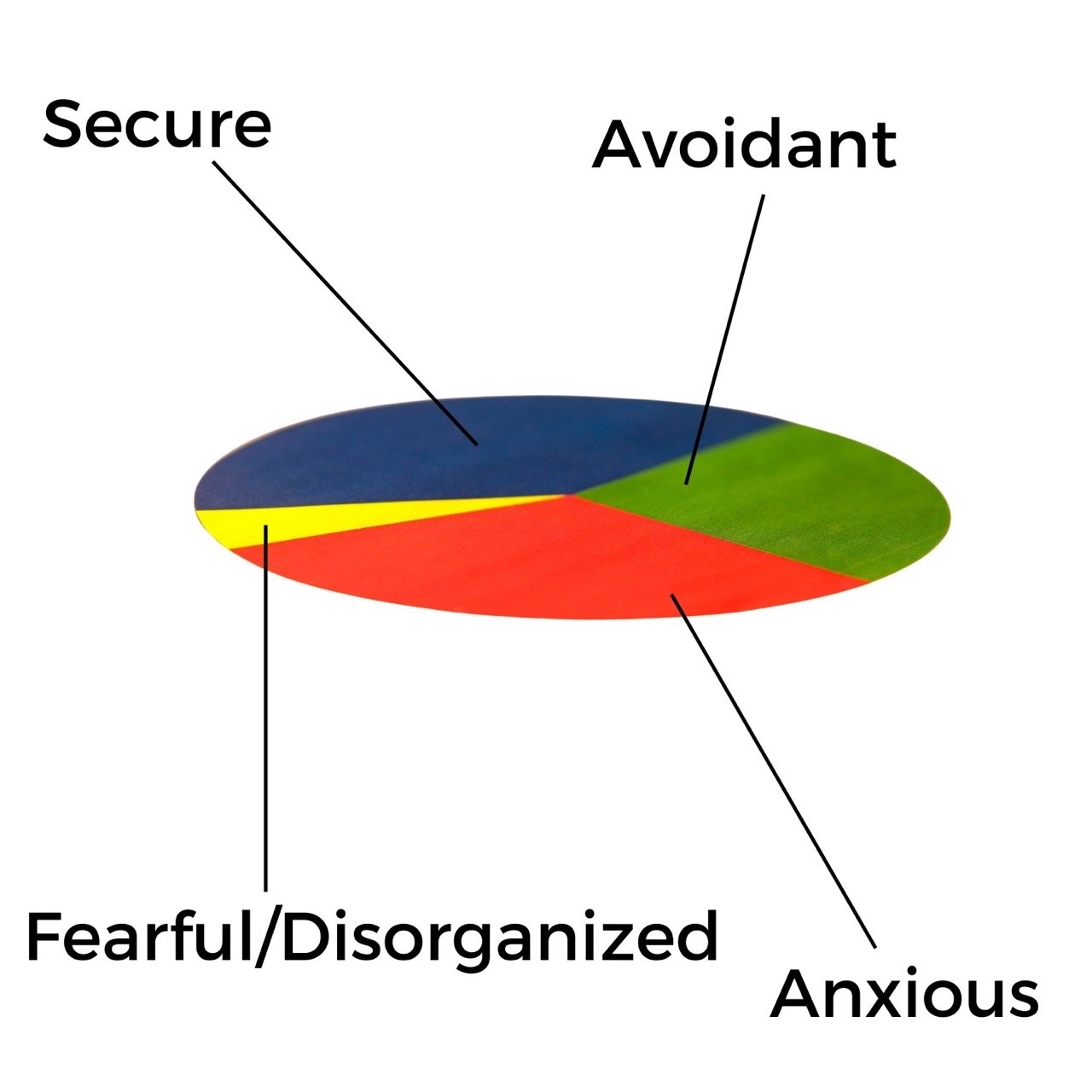You Are More than One Attachment Style
If you’ve learned about attachment theory, you’ve probably learned that you have an attachment style that predicts how you go about relating with people. How you start relationships, how your relationships go, and how they end.
In fact, attachment theory helps us understand our patterns when it comes to bonding with others. It helps us understand that we are hardwired to seek out support from other people. Predictable physical and/or emotional connection with an attachment figure is calming to our nervous system and gives us a sense of a safe haven when we are young. The theory helps us make sense of our history, because it explains how we develop secure or insecure attachment style based on how we interacted with caregivers when we were young.
But some people are surprised to realize that they have more than one attachment style, and if they’re stuck in their self-growth journey it’s because they haven’t addressed these other styles.
First, a quick recap of the attachment styles:
There is one secure attachment style and three insecure attachment styles.
Secure Attachment:
Feel relatively comfortable with ebbs and flows in connection in relationships
Had a caregiver who was consistently available, attuned, and connected on an emotional level
Able to talk through conflict in the moment or give someone space to talk when they’re ready
Relatively confident in their own abilities and who they are
Tend to form long-term relationships relatively easily
Capable of calming themselves and calming others
Anxious/Ambivalent Attachment:
Fear abandonment in relationships
Had a caregiver who was inconsistently available
Want to talk through conflict when upset
Look for external validation to boost esteem
Look for other people to soothe them
Avoidant Attachment:
Fear being smothered in relationships
Had a caregiver who was critical, unavailable, or unemotional
Don’t like talking through conflict when upset, would prefer to calm down and take some space
Feel comfortable enough in themselves to be alone or date casually
Prefer to calm themselves down, often through distraction or withdrawal
Fearful/Disorganized/Anxious-Avoidant Attachment:
A mix of anxious and avoidant styles; may oscillate between anxious and avoidant, or lean more towards one style
Had a caregiver who was unsafe physically or emotionally, or even just chaotic
Fear romantic partnerships and bad relational outcomes, so push people away
Want intimacy yet fear being close to people
Have trouble self-soothing or calming themselves down
This style often stems from trauma
Notice your attachment style in friendships, in dating, at work
Once you understand your dominant attachment style, you can notice how it shows up in dating, partnership, friendships, with family, at work. For example, when you are upset do you tend to be independent and calm yourself down, or do you first go to a friend or loved one for support? Do you build relationships with people easily, or does it almost feel easier to have relationships with animals? Do you like having your own space and inviting people into it, or are you comfortable accepting other people’s invitations to spend time together? Once someone expresses they would like to spend time together, do you feel annoyed at the interruption, or can you happily drop what you’re doing to talk to someone?
Learn strategies for your attachment type
If it turns out your primary attachment style is anxious, avoidant, or disorganized, you can learn strategies to become more secure in relationships. If you have a more anxious style, you can learn ways to feel more relaxed when people aren’t always consistent or predictable with their availability. If you have a more avoidant style, you can learn strategies for what to do when people press you for your time or resources, or can’t seem to have boundaries for their behavior. And if you have disorganized/anxious-avoidant attachment, you can learn ways to feel less triggered and more calm around people, and to feel less hot/cold in your relationships and more consistent warmth.
We have a mix of attachment styles
But focusing on just one attachment style means we might not recognize the ways we exhibit elements from the other three styles. Most of us have a mix of different attachment styles that show up at different times or in different places. You are not a hundred percent anxious all the time. Nor are you a hundred percent avoidant with a neighbor yet absolutely secure with your best friend. Instead, someone might be secure with a friend most of the time, able to share laughter and tears, hurts, and stories, giving and receiving vulnerably. But when trouble comes up in the friendship — a misattunement, or difference in needs or opinions, people fall back into an insecure style.
Attachment style as toppings on a pizza
You can think of attachment style as a blend, kind of like a pizza with toppings of Secure, Anxious, Avoidant, or Fearful attachment style. Most people who order pizza toppings don’t put all the olives by themselves on a quarter of the pizza with no other toppings (no judgment if you do!) Instead, they are sprinkled liberally across the entire pizza, mixed in with some pepperoni, bell pepper, or mushrooms. Sure you might get a pizza with olives just on one half, just like you might be partially anxious with a friend when you don’t hear from them in a long time. In contrast, you have another friendship where you both keep in regular contact and feel fundamentally secure.
Attachment style is like a pizza — it usually has more than one topping
Examples of mixed attachment styles
Consider the person who is in a happy, long-term committed relationship. However, when they see their partner smiling and laughing with an attractive co-worker at a dinner party, they feel a touch of jealousy that later turns into a fight, and they confess to their partner that they occasionally feel insecure when their partner is enjoying themselves with other people. (Secure with some anxious attachment)
Or the woman who is dating and chasing the men who are attractive to her but who are ultimately unavailable for the degree of emotional connection she wants. However, when an emotionally available man becomes interested in her, she doesn’t feel attracted to him, so she is cool and unresponsive. (Anxious with the occasional avoidant stance)
Or the man who normally attracts people who he describes as clingy and high maintenance, and finally meets someone who acts independent and self-sufficient, but it turns out to be a little too independent. He finds himself in the uncharacteristic role of feeling like the anxious one who wants to spend more time together. (Avoidant with a situational anxious stance)
Or the person who has a pattern in relationships to 1) get to know someone 2) finally feel like they’ve found the perfect partner 3) begin to notice less than ideal traits 4) feel more and more uncomfortable in the relationship 5) end the relationship and feel relief and 6) start to feel lonely and look for a partner. This is a common “fearful avoidant”, or disorganized-leaning-avoidant pattern. But if this person’s partner interrupts the pattern by ending the relationship first due to not having their own needs met, this person can feel their own anxiety and fears around abandonment. (Disorganized with the occasional anxious stance)
Someone who is mostly anxious and secure with a little bit of disorganized/fearful/anxious avoidant attachment might have a few secure friendships but fear making new friends or finding a romantic partner, because they don’t want the drama or the heartache. They’ve been burned a few times in relationships and don’t trust fully that a relationship will work out. But they have enough secure attachment in their makeup to have some solid friendships. Or they might have a long-term romantic partnership but have ups and downs in their friendships. The more disorganized/fearful attachment they have in their mix, the more they feel dysregulated, strive to control themselves and their environment, fight being controlled by their urges and triggers, and struggle to maintain long-term relationships due to high conflict.
Or perhaps they are a blend of avoidant and disorganized and secure. In this case, they might be highly independent and take pride in their self-sufficiency, yet long for someone to be their safe harbor. Past experience tells them that being vulnerable is unsafe, so they fluctuate between vulnerability and distance in their relationships in order to feel safer. This Fearful Avoidant attachment can be isolating and painful.
These are just a few scenarios — there are many possibilities in relationships, just as there are many configurations of toppings on a pizza. And attachment is not static, it changes, so it’s more like a pizza where you’re constantly adding and removing toppings. Fortunately, if you’re willing to work at it, you can have more of the toppings you like on your pizza — more secure attachment!
How does your attachment style change over time?
Imagine for a moment someone who has a good relationship, be that a romantic relationship or friendship. And then they go through hard times — perhaps a financial, health, relational, or even a global difficulty. Their relationship is strained by these external stressors, and eventually they part ways with their friend or former beloved. This is a kind of trauma - small in the case of ending a casual acquintance-type relationship, large in a divorce. This might even increase their fearful avoidant/disorganized attachment for a time. You can probably think of people you know or stories of people who suffered a terrible heartbreak, underwent a great loss, or were down on their luck, and then withdrew from the world, cutting themselves off from people, before regaining their footing and forming close relationships again. Our sense of security can fluctuate in life as we go through natural ups and downs.
The shift toward secure attachment
But fortunately there are ways to calm the attachment system and bring us back toward secure attachment.
For the Anxious style, you can work with boundaries, self-love, and self-soothing, so you don’t have to rely on external validation to feel secure.
For the Avoidant style, you can work on noticing and changing your withdrawal strategies, transitions into connection, making a shift toward activities where you engage in social interactions, and learning how to identify and make room for your own needs while staying in connection.
For the Disorganized/Anxious-Avoidant style, you can benefit from learning to self-soothe and regulate your emotional state and tolerate other people’s emotions. The key to beginning to feel safe is to find the safety inside of you. Someone working with this style can also work with strategies for Anxious or Avoidant styles — whichever fits them most closely.
If you’d like to continue learning about attachment and how to get more secure relationships, subscribe below to receive posts like this in your email. You will also get subscriber-only audio and course discounts — I typically send a few emails a month.
Want to create more understanding and mutual connection in your relationships? Check out this course for anxious attachment: Secure Attachment Rewire






